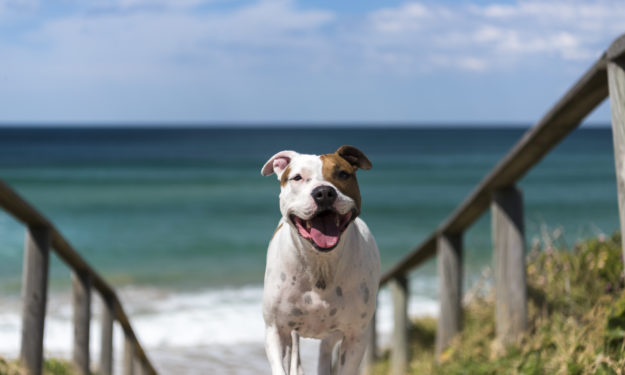Beach Dangers for Your Dog
August 16, 2018
Written by Krista Vernaleken, VMD
Ahh, a day at the beach. The sun gently warms you while you lounge, your toes squish in the sand, and a light sea breeze keeps you at just the right temperature. You can hear the waves crashing in the distance. You’re getting a little hungry and looking forward to that lunch you packed and capping it off with ice cream from a little ice cream shop nearby that has been there for generations.
The only thing that would make it more complete would be if you could share it with your beloved dog. Oh, wouldn’t they love it? They could frolic in the waves, dig in the sand, gnaw a chewy by your side while you lounge.
But actually, the reality of the beach has a lot more peril and other potential issues than you might think. That doesn’t mean that the beach isn’t a place for your dog, but you do need to consider whether your dog might be at risk for some of these concerns.
Follow the Rules
Make sure you take your dog to a dog-friendly beach. Double check the hours that your dog is welcome, and definitely pick up after your dog’s bathroom breaks!
Not Everyone Loves Your Dog (Gasp!)
The first is purely related to other people and the impact you may have on them with your dog. Many people are dog lovers, but many people are not. They do not mind sharing the beach, but certainly would not appreciate having a random wet dog walk up to them for a snuggle, or a slobber. Or if they left their area unattended to go for a dip, to have their items rifled through or peed on. Or to be covered in sand from an enthusiastic digging session or a running pooch. These aren’t things dogs do on purpose, and they theoretically would be avoided by conscientious owners keeping their well-mannered dogs on leashes. But alas, not all owners are conscientious and not all dogs are well-mannered. It is for this reason that many beaches do not allow dogs during peak seasons or certain times of the day, and those rules need to be respected. Even if there aren’t restrictions, keep in mind that your dog might not be perfect and make every attempt to avoid your wonderful day impacting the ability of another person to enjoy their day.
Natural Hazards
From the perspective of safety on the beach, there are some unique concerns. Saltwater, sand, and the high concentration of possible hazards (natural and those left by people) make it more possible for dogs to run into trouble than perhaps on a wooded trail.
All That Salt…
Saltwater can be ingested in only very small quantities safely. When dogs drink a lot, either purposefully (they’re thirsty and don’t know any better) or accidentally (while swimming/fetching/having a glorious time), they are ingesting a large quantity of sodium. Sodium is a necessary electrolyte present in all of the cells, tissues, and bloodstream. It is also very tightly regulated and a sudden ingestion of large quantities of sodium will cause significant problems, most concerningly in the brain, and can actually cause death. For more information on this, see our salt toxicity blog.
…And All That Sand
In the process of picking up balls, toys, and playing, dogs can also ingest large amounts of sand, leading to a sand impaction. And boy, can they eat a lot of sand!
Mind the Heat
Hot sun, sand, and no shade could also set your dog up for heat stroke. Remember that your dog can’t sweat and can’t tell you when the heat is too much. Always have water available and bring an umbrella or tent for shade if you’ll be lounging for a while. To learn about what to watch out for, see our heat stroke and overheating blog.
Lots of Things to Eat, and Step On
Objects can be found on the beach that dogs wouldn’t normally find and they may eat or try to eat them out of curiosity. Natural objects like shells, seaweed, and dead creatures might be fun to play with, but could cause bacterial infections, cracked teeth, intestinal obstructions, or even esophageal obstructions. If you’re at a rougher beach, sharp rocks or seashells could cut your dog’s paw pads and cause bleeding and limping. And when you put a large number of people in a small space like happens at the beach, garbage and objects left behind also might be present and cause similar issues. Keep a close eye on them always, they are sneaky and it only takes a few seconds to get that rotten oyster into their tummy.
Friends, or Foes
Finally, there are other dogs. At times of the year that dogs are allowed on beaches, dogs often can be found in higher numbers and are often off-leash. That can be a fun dog park-like experience, but if you don’t know the dogs there, watch out for any signs of aggression. See our dog park safety blog for more tips.
Symptoms to Watch Out for Post-Beach
Go to a veterinarian immediately if your dog shows disease or injury symptoms after a beach visit including:
- Lethargy
- Vomiting or diarrhea
- Seizures
- Bleeding
- Limping
We want you to have a great day at the beach, so don’t be too nervous about all the trouble your dog can run into, they can get into trouble at any time, and I”m sure you know that!
Most of these dangers are preventable simply by keeping your dog on a leash, making fresh water available at all times, and providing shade.
Pay attention to what they are getting into and try to avoid any inappropriate ingestions; and have a great beach day!